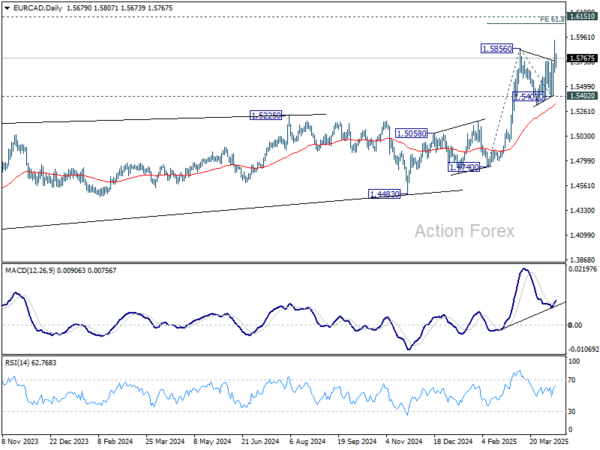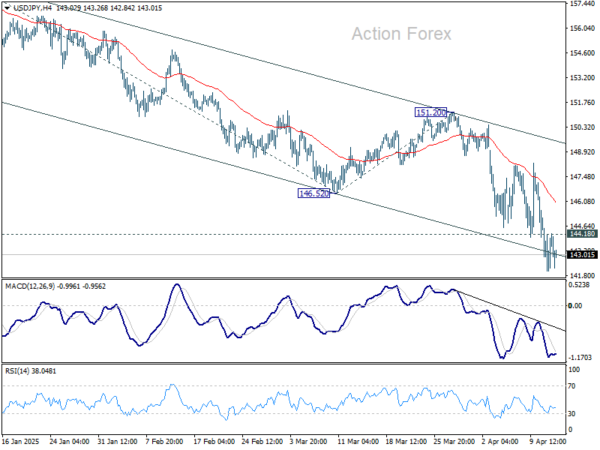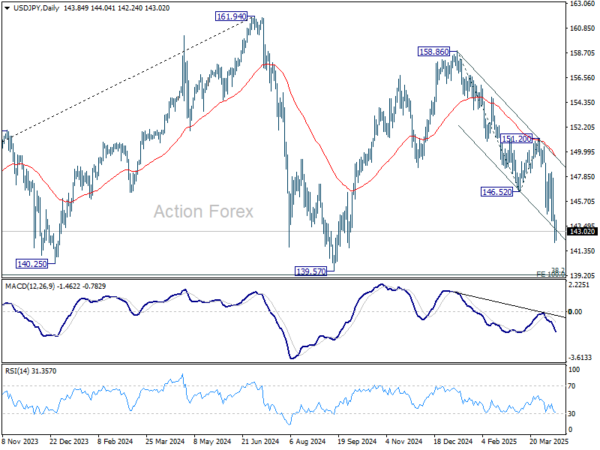Financial markets opened the week on a relatively steady footing in Asia, offering investors a brief respite after last week’s extreme volatility driven by US tariff chaos. Major stock indexes are trading higher, though gains appear more a product of technical consolidation than renewed optimism.
In currency markets, most major pairs and crosses are contained within Friday’s range. The exception is some Kiwi pairs, which have moved with a bit more momentum. For now, it appears that volatility has pulled back from the extremes seen over the past two weeks, giving investors a brief window of breathing space.
Nevertheless, confusion around U.S. tariff policy continues to muddy the waters. Reports emerged over the weekend that key Chinese exports such as smartphones and computers would not be subject to the full 145% tariff hike. Instead, they would face a 20% rate. However, U.S. President Donald Trump quickly reignited uncertainty by stating he would announce a separate tariff on semiconductors next week, alongside a new national security probe targeting the chip sector. This piecemeal, ad hoc rollout is making it difficult for markets to price in risk or clarity.
On the diplomatic front, Chinese President Xi Jinping’s visit to Vietnam signals a strategic push to shore up regional supply chains as China faces growing trade isolation from the US. Xi’s trip, which also includes stops in Cambodia and Malaysia, highlights Beijing’s urgency in hedging against further decoupling with the US. Meanwhile, Vietnam is caught in the middle — a beneficiary of supply chain shifts, but also under scrutiny from Washington, facing a potential 46% US tariff if it fails to enforce tighter rules of origin.
Looking ahead, the spotlight will shift BoC and ECB rate decisions, both facing the delicate balancing act of responding to weakening growth and potential inflationary shocks from tariffs. Meanwhile, a heavy slate of data—including US retail sales, Germany’s ZEW survey, UK employment and CPI, New Zealand’s inflation report, and China’s Q1 GDP—will provide further clues on the economic fallout of the trade conflict.
Technically, EUR/CAD’s late break of 1.5856 resistance last week indicates medium term up trend resumption. Near term outlook will now stay bullish as long as 1.5402 support holds. Next target is 61.8% projection of 1.4740 to 1.5856 from 1.5402 at 1.6092. That would be close to 1.6151 key long term resistance (2018 high).
In Asia, at the time of writing, Nikkei is up 1.91%. Hong Kong HSI is up 2.43%. China Shanghai SSE is up 0.70%. Singapore Strait Times is up 1.54%. Japan 10-year JGB yield is down -0.012 at 1.334.
BoJ’s Ueda: US tariffs add downside risks to Japan through various channels
BoJ Governor Kazuo Ueda warned today that the recently imposed U.S. tariffs are likely to exert “downward pressure” on both the global and Japanese economies through “various channels.”
While he did not specify the transmission mechanisms, the remarks reflect growing concerns that escalating trade tensions could weigh on exports, dampen corporate sentiment, disrupt supply chains, as well as trigger volatility in the financial markets including currencies.
Ueda reiterated BoJ’s commitment to achieving its 2% inflation target sustainably, noting that monetary policy would be guided appropriately based on evolving economic, price, and financial developments. He emphasized that the central bank will maintain a data-dependent approach and continue to scrutinize conditions “without any pre-conception”.
NZ BNZ services rises to 49.1, subdued despite hints of stabilization
New Zealand’s services sector remained in contraction in March, with the BusinessNZ Performance of Services Index inching up slightly to 49.1 from 49.0. This marks another month below the long-run average of 53.0 highlighting the ongoing weakness.
While the headline improvement was minimal, underlying components showed a mixed picture—activity/sales dropped from 49.1 to 47.4. But new orders/business climbed from 49.5 to 50.8, the highest since February 2024, suggesting some pickup in future demand. Employment rose from 49.1 to 50.2, ending a 15-month streak of contraction, and offering early signs that firms may be regaining confidence in hiring.
The share of negative comments from survey participants fell slightly to 56.7%, with ongoing concerns about high interest rates, inflation, weak consumer sentiment, and broader economic uncertainty. Businesses also cited external pressures such as global tariffs and rising input costs.
China’s export surge 12.4% yoy in Mar, imports down -4.3% yoy
China’s exports jumped an impressive 12.4% yoy to USD 313.9B in March, significantly beating expectations of 4.4% yoy and marking a sharp acceleration from the 2.3% yoy growth recorded in January-February.
Particularly notable was the 9.18% yoy rise in shipments to the US, likely due to front-loading ahead of tariff tensions. Exports to ASEAN also strengthened with 11.6% yoy growth , with double-digit growth to major partners like Thailand (27.8% yoy) and Vietnam (18.9% yoy).
However, Vietnam, a key intermediary in China’s export supply chain, is now under pressure to tighten controls on the origin of goods and materials. According to a ministry document, authorities in Hanoi are urging companies to clamp down on origin fraud to avoid punitive US tariffs, highlighting growing scrutiny on Chinese goods routed through third countries.
Meanwhile, the strength in exports contrasted with a -4.3% yoy decline in imports, resulting in a larger-than-expected trade surplus of USD 102.6B.
Fed’s Kashkari: Markets searching for “new normal” amid trade policy uncertainty
Minneapolis Fed President Neel Kashkari acknowledged over the weekend that global investors are grappling with deep uncertainty surrounding the direction of US trade and fiscal policy. Speaking on CBS’s Face the Nation, Kashkari said the bond market’s recent volatility reflects an effort to “determine what is the new normal in America,” particularly regarding long-term Treasury yields.
He emphasized that Fed has “zero ability” to influence that end point, which he said is shaped entirely by trade negotiations and fiscal decisions coming out of Washington.
Kashkari underlined that tariffs are inherently inflationary, but the key question is whether their effect on prices will be temporary or more sustained. “Tariffs push up prices and push down economic activity,” he noted, describing it as a difficult scenario in which Fed’s tools are limited. The central bank’s role, he added, is “to make sure that it’s only a one time adjustment in prices and nothing longer term than that.”
He also made clear that monetary policy alone cannot undo the economic drag from a trade war. As the market digests new rounds of tariffs, retaliation, and policy reversals, Kashkari said, “we’re going to have to watch and see.”
“We can just keep inflation from getting out of hand,” he added.
Tariff Shockwaves Test BoC and ECB Resolve
Markets head into the holiday-shortened week with anticipation as a string of key central bank decisions including BoC and ECB, as well as critical economic data are featured.
BoC meeting is shaping up to be one of the most uncertain in the past two years. Markets are split, with investors pricing in roughly a 60% chance that BoC will pause its easing cycle this week. After cutting rates again in March, the central bank emphasized that it would “proceed carefully with any further changes” due the growing complexity in the economic outlook.
The key dilemma for BoC is whether they prioritize tackling inflation risks from tariff pass-through or opt for a preemptive cut to support growth. If the BoC tilts toward the latter, it could deliver a pre-emptive 25 bps rate cut to continue its path toward a less restrictive 2.50% rate.
The decisive factor could be the March CPI data, released a day ahead of the policy announcement. If the report confirms that February’s surprise spike in both headline and core inflation was indeed transitory, BoC would have sufficient cover to proceed with another rate cut. Otherwise, a hold is the more cautious move.
ECB is also in the spotlight. According to a Reuters poll, 61 of 71 economists expect a 25bps cut to the deposit rate, bringing it down to 2.25%. A further cut to 2.00% is widely anticipated for June. While ECB policymakers have largely avoided clear forward guidance amid the rapidly shifting trade environment, the general tone suggests a growing focus on downside risks to growth rather than inflation persistence.
In Australia, minutes of RBA’s April meeting are expected to reiterate the central bank’s cautious tone and reluctance to commit to further easing just yet. However, labor market data later in the week could test RBA’s resolve. A weaker-than-expected jobs report would likely increase market bets that RBA will restart rate cuts in May. Ultimately though, Q1 CPI data due on April 30 remains the definitive piece of the policy puzzle.
On the data front, U.S. retail sales will be a critical gauge of how much the tariff-induced uncertainty has dampened actual household spending. Meanwhile, Germany’s ZEW economic sentiment index should offer a timely look at how sharply European business confidence has been hit by the escalating trade war. Other key releases include UK employment figures and CPI data, New Zealand’s CPI, and China’s Q1 GDP.
Here are some highlights for the week:
- Monday: New Zealand BNZ services; China trade balance; Swiss PPI; Canada wholesale sales.
- Tuesday: RBA minutes; UK employment; German ZEW economic sentiment; Eurozone industrial production; Canada CPI, manufacturing sales; US Empire state manufacturing, import prices.
- Wednesday: Japan machine orders; China GDP, industrial production, retail sales, fixed asset investment; UK CPI; Eurozone CPI final; US retail sales, industrial production, NAHB housing index; BoC rate decision.
- Thursday: New Zealand CPI; Australia employment; Japan trade balance; Swiss France balance; ECB rate decision; US jobless claims, Philly Fed survey, building permits and housing starts.
- Friday: Japan CPI.
USD/JPY Daily Outlook
Daily Pivots: (S1) 142.16; (P) 143.44; (R1) 144.81; More…
Intraday bias in USD/JPY remains on the downside for the moment. Current fall from 158.86 is in progress to 139.57 support. On the upside, above 144.18 minor resistance will turn intraday bias neutral first. But outlook will stay bearish as long as 151.20 resistance holds, in case of recovery.
In the bigger picture, price actions from 161.94 are seen as a corrective pattern to rise from 102.58 (2021 low), with fall from 158.86 as the third leg. Strong support should be seen from 38.2% retracement of 102.58 to 161.94 at 139.26 to bring rebound. However, sustained break of 139.26 would open up deeper medium term decline to 61.8% retracement at 125.25.

















